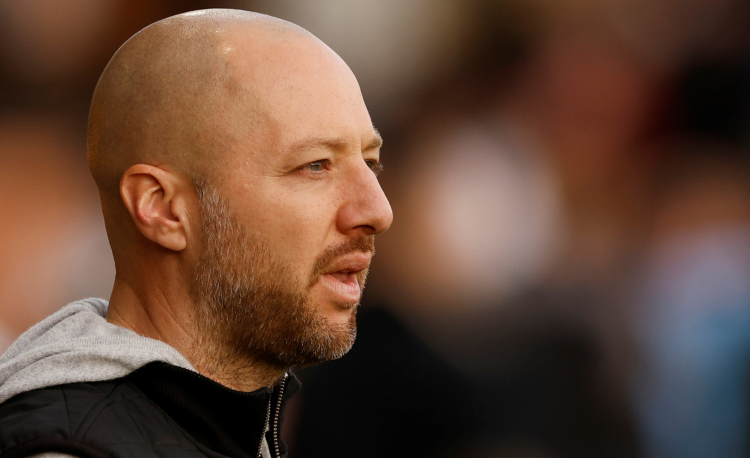You are viewing 1 of your 1 free articles
Breaking down a defensive block
This is a session focused on breaking down a defensive block. It is the final part of an attack if you have successfully progressed possession into the attacking third.
| Area | Full pitch |
| Equipment |
Cones, mannequins, 4 mini goals, full size goal |
| No. of Players | 20 players + 2 goalkeepers |
| Session Time | Passing practice: 10mins including breaks Functional practice: 20mins 11v11: 25-30mins |
This is a session focused on breaking down a defensive block. It is the final part of an attack if you have successfully progressed possession into the attacking third. The scenarios are particularly relevant for teams who have higher amounts of possession. Across all leagues, we regularly see very well organised defensive structures with high levels of compactness and concentration. Therefore the hardest part of the game is becoming even harder. There is less space, less time, and increasingly well-drilled defensive units.
As a theme, this is something that I focus on regularly. It is important to have a collective structure with the positional play of the entire team but also to allow individual creativity and ingenuity within that structure. It is also a part of the game which I feel is going to become more and more relevant in the future as the physical capabilities of players continually increases alongside the ability of coaches in structuring and organising their defences.
It is a demanding session mentally, but a very productive one when structured well. Quite often I would also have a member of the coaching staff working with and challenging the defending team to ensure all players are developing during the session.
“The hardest part of the game is becoming even harder”
PASSING PRACTICE
This first section is a passing practice with an emphasis on penetrating the defensive line in central areas. Generally we would work with the midfield and forward players while the defensive players work on their own specific passing practice. However, it could easily be done with all players involved.
We have a minimum of five players in each group, with mannequins set up 16-22yds from the target goals (this distance can be adjusted to increase or decrease space, and the set-up can be manipulated to replicate the opposition’s defensive block or to emphasise spaces to exploit). There are also three cones, with approximately 12yds between them.
The ball starts from the marker closest to the target goal. They pass backwards to the first receiver, who pivots and passes back to the second receiver, who then combines with the player inside the mannequins [1a]. This player penetrates the defensive line and finishes into the target goal [1b].
[1a & 1b]
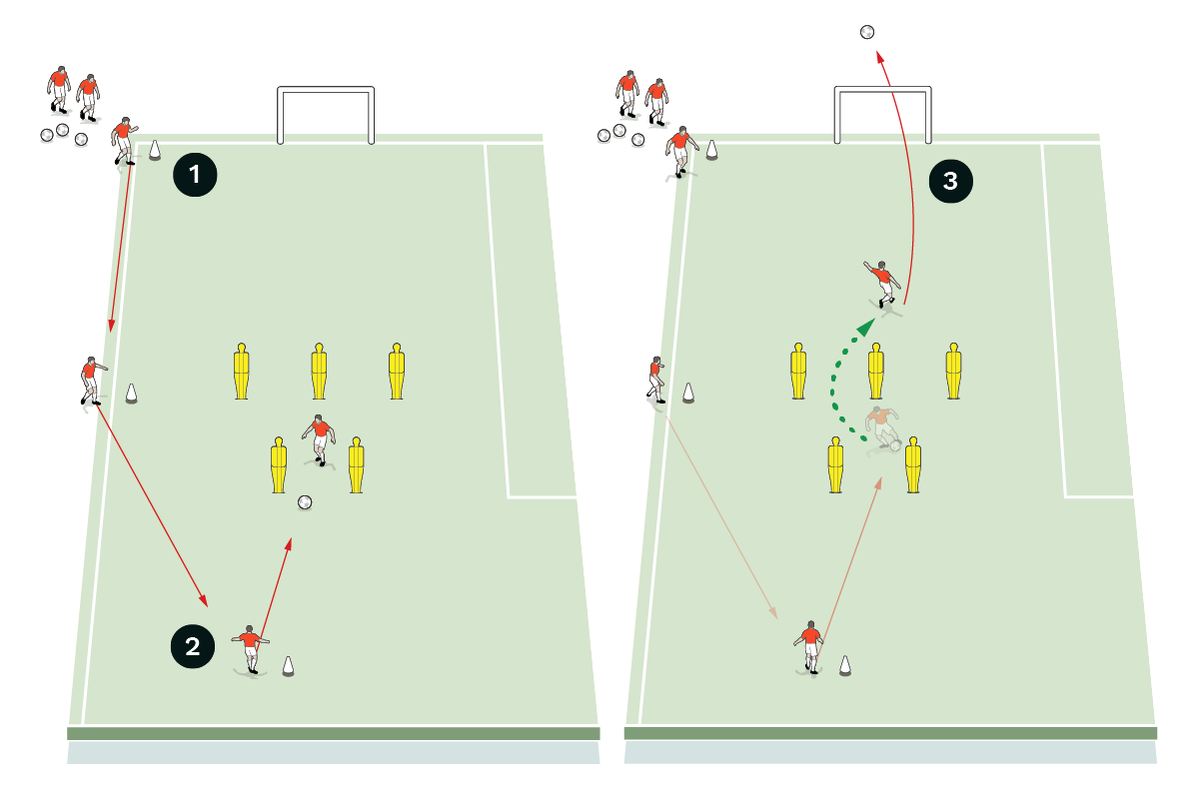
-
The ball starts from the marker closest to the target goal.
- They pass backwards to the first receiver, who pivots and passes back to the second receiver, who then combines with the player inside the mannequins.
- The player inside the mannequins penetrates the defensive line and finishes into the target goal.
The players then rotate one position clockwise, with the player who finishes joining the start position.
Do two sets on the left side, two sets on the right side, 4x90secs to 2mins.
The first pass should be played firmly and into the back foot of the receiver, who needs an open body shape to pivot and pass quickly to the second receiver. The second receiver has to make decisions and execute them quickly; depending on the weight of the pass received, they can play off one touch or two touches, and depending on the movement of the player inside the mannequins, they can pass and support to combine, or penetrate with one pass. Timing and clarity of movement is also key; they need to arrive in space to combine and then penetrate, or make a direct movement in order to penetrate the defensive line.
To make it more challenging, you can increase the tempo once the second receiver has the ball, which encourages improved technical execution at maximum speed.
FUNCTIONAL PRACTICE
Here we will have 13 players plus goalkeepers [as shown], or 20 players and double up in the attacking positions. We work approximately 35-40yds from goal, with angled sides to cut the edges off the pitch, and four target goals across the width of the pitch.
The ball is served in from the goalkeeper between the central target goals into either of the pivots. The receiving pivot passes to the other pivot, who opens up and passes to the wide forward [2a].
[2a]
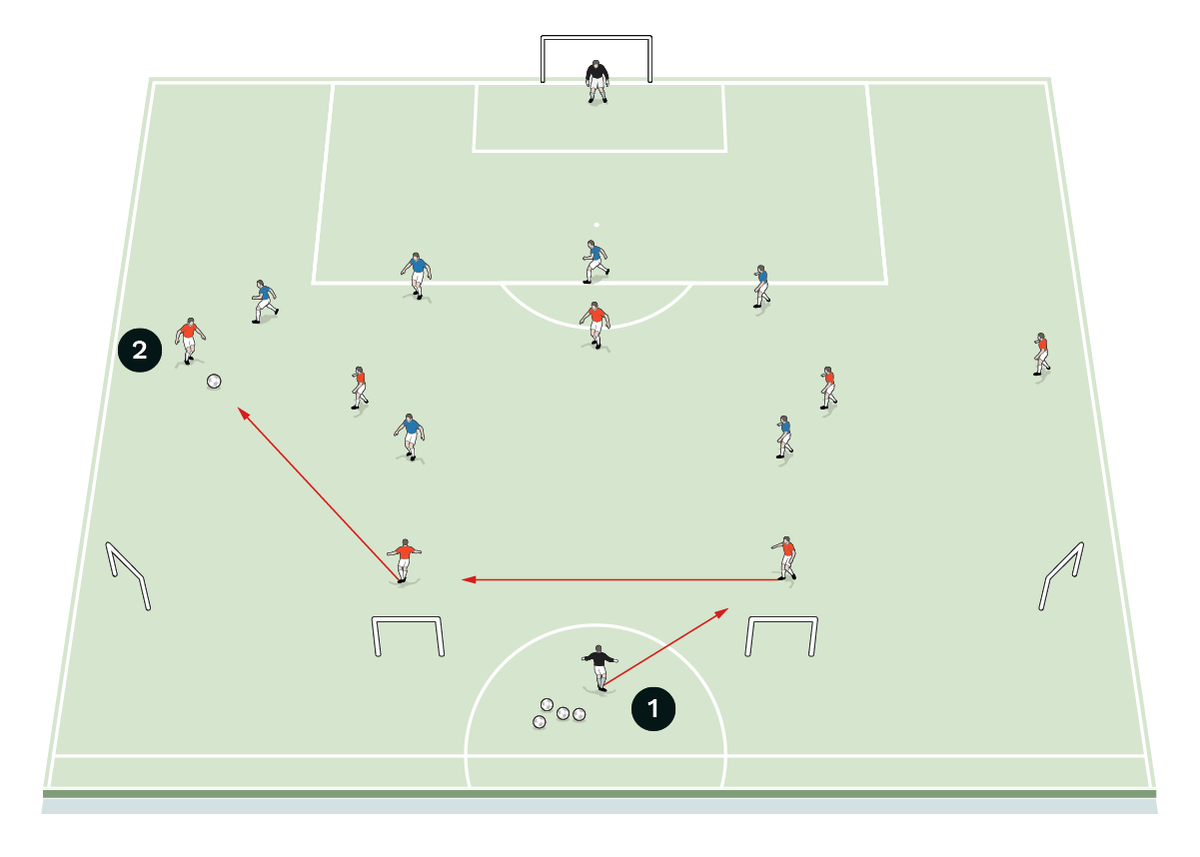
-
The ball is served in from the goalkeeper between the central target goals into either of the pivots.
- The receiving pivot passes to the other pivot, who opens up and passes to the wide forward.
We can then work three scenarios from this position [2b]:
1) The attacking midfielder runs between the full back and centre back to penetrate from half space.
2) The attacking midfielder overlaps the wide forward as they drive inside at the full back.
3) The attacking midfielder supports on the inside shoulder of the full back, providing a one-two for the wide forward.
[2b]
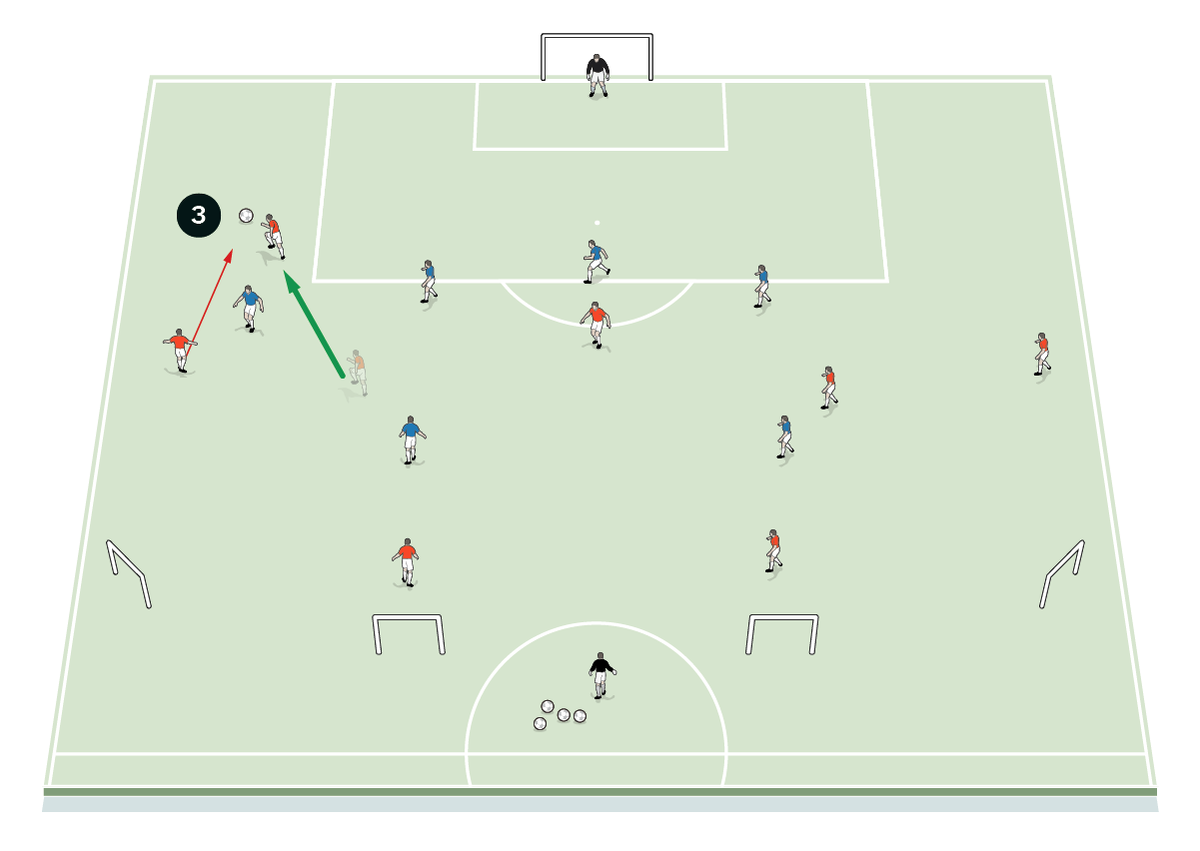
-
The attacking midfielder offers support for the wide forward, reading triggers for movements and watching the full back.
The defenders then attack the target goals on transitions.
We would run this practice for four to six attacks on each side for each scenario per attacking group.
Some of the things to think about here are the tempo and detail of passes to maximise time and space for the wide forward, the importance of discipline in positioning for the attacking midfielder, reading triggers for movements (how wide the forward receives, making visual contact, whether they drive inside or maintain width, and how the full back is affected), and the dynamism and speed of movement as players seek to create and exploit the 2v1 situation. The wide forward should maximise space, receiving open when possible, considering the detail of passes when sliding behind for the attacking midfielder, and the speed and timing of 1-2 to accelerate behind the defensive line. Going beyond the defensive line is a trigger to arrive into scoring positions in the box. Players also need to consider their positioning behind the ball to prevent any counter-attacks.
The challenge is to penetrate the defensive line regularly, to create and take chances, and to prevent the defensive team from scoring in the target goals on any transitions.
“Think about the tempo and detail of passes to maximise time and space for the wide forward”
11v11
We finish with an 11v11, looking to bring this all together and to provide repetitions in trying to break down this defensive block. As well as the focus on the attacking play in order to maximise the chances created, I would also have a strong emphasis on pinning the attack in.
We have 22 players, including goalkeepers, and four target goals set up 12-15yds into the defensive half.
The play starts from the resting goalkeeper passing into the attacking team. The attacking team attempt to break down the defensive block to create and score [3a].
[3a]
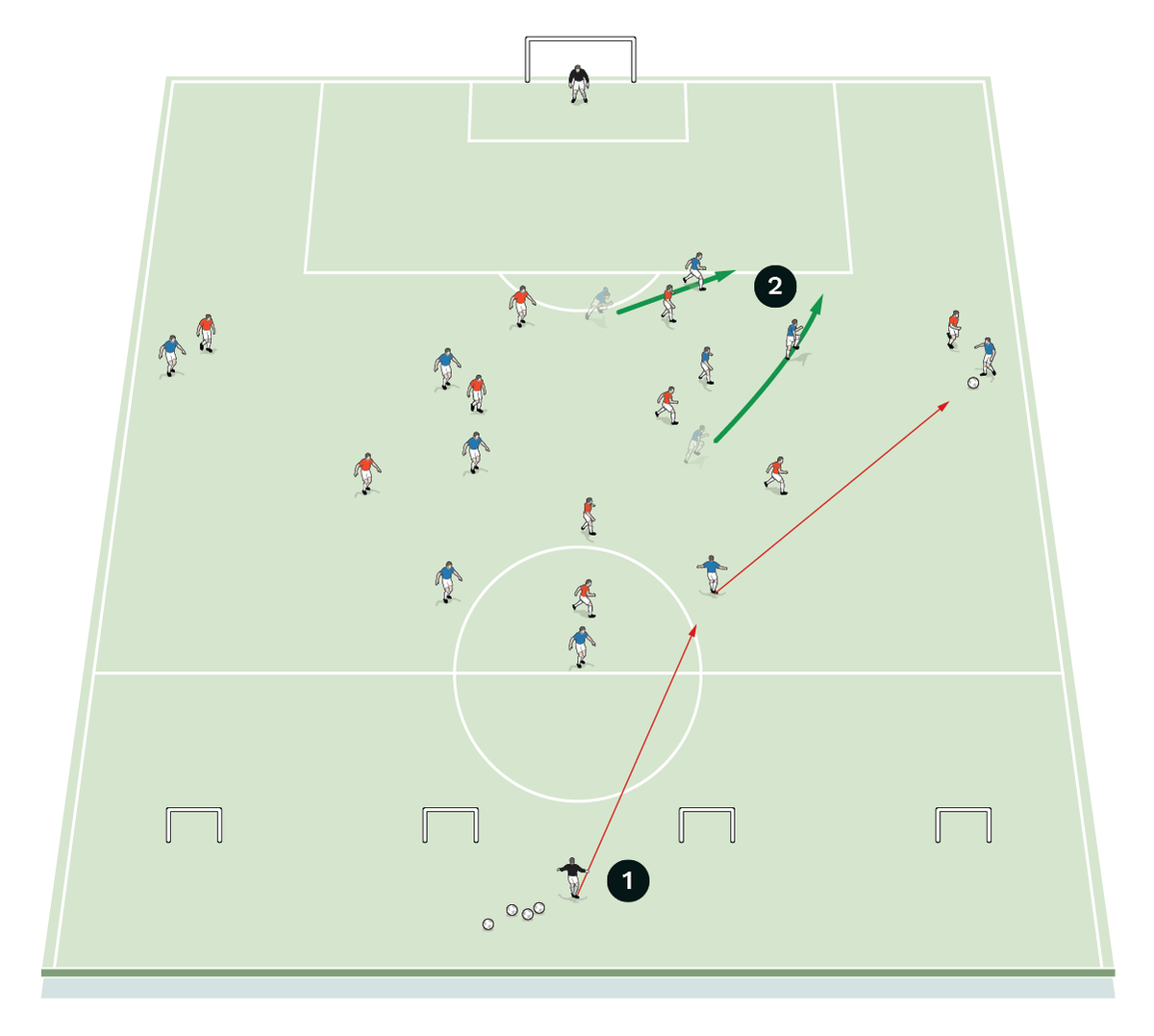
-
The play starts from the resting goalkeeper passing into the attacking team.
- The attacking team attempt to break down the defensive block to create and score.
The defensive team attack the target goals on transition, and have to be over the halfway line to score.
You can adjust the attacking structure and defensive structure as required to match your own team and your upcoming opposition.
The key points here are to encourage positional play to progress into the attacking third, keeping our tactical discipline to stretch and occupy the defensive line, and making decisions and executing them to penetrate. The defensive line being penetrated is a trigger to arrive with numbers into the box and to squeeze in behind to sustain the attack and prevent the counter-attack. If the attacking team is unable to penetrate due to pressure, switch, and target other spaces on the opposite side of the pitch.
The aims are to maximise chances and take them, to sustain attacks through the second or third phase, and to minimise the defensive team’s progression over the halfway line.
The ability to sustain attacks and not allow the defending team to break down the pitch on transitions is huge. If this practice is done well, it is possible to gain significant control and domination of games. As well as the essential technical and tactical points, there also needs to be high levels of bravery and concentration.
Related Files
Editor's Picks
Deep runs in the final third
Using the goalkeeper in build-up play
Pressing principles
Intensive boxes drill with goals
Penetrating the final third
Creating and finishing
My philosophy
Pressing initiation
Compact team movement
Coaches' Testimonials

Alan Pardew

Arsène Wenger

Brendan Rodgers

Carlos Carvalhal

José Mourinho

Jürgen Klopp

Pep Guardiola

Roy Hodgson

Sir Alex Ferguson

Steven Gerrard
Coaches' Testimonials

Gerald Kearney, Downtown Las Vegas Soccer Club

Paul Butler, Florida, USA

Rick Shields, Springboro, USA

Tony Green, Pierrefonds Titans, Quebec, Canada
Join the world's leading coaches and managers and discover for yourself one of the best kept secrets in coaching. No other training tool on the planet is written or read by the calibre of names you’ll find in Elite Soccer.
In a recent survey 92% of subscribers said Elite Soccer makes them more confident, 89% said it makes them a more effective coach and 91% said it makes them more inspired.
Get Monthly Inspiration
All the latest techniques and approaches
Since 2010 Elite Soccer has given subscribers exclusive insight into the training ground practices of the world’s best coaches. Published in partnership with the League Managers Association we have unparalleled access to the leading lights in the English leagues, as well as a host of international managers.
Elite Soccer exclusively features sessions written by the coaches themselves. There are no observed sessions and no sessions “in the style of”, just first-hand advice delivered direct to you from the coach.
